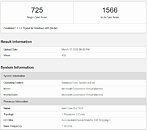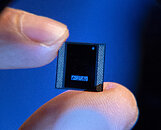Monday, March 23rd 2020

Intel Core i5-L15G7 Lakefield Processor Spotted
Intel has been experimenting with a concept of mixing various types of cores in a single package with a design called Lakefield. With this processor, you would get a package of relatively small dimensions that are 12-by-12-by-1 millimeters withing very low TDP. Thanks to the Twitter user InstLatX64 (@InstLatX64) we have some GeekBench 5 results of the new Lakefield chip. The CPU in question is the Core i5-L15G7, a 5 core CPU without HyperThreading. The 5C/5T would be a weird configuration if only Lakefield wasn't meant for such configs. There are one "big" Sunny Cove core and four "small" Tremont cores built on the 10 nm manufacturing process. This is the so-called compute die, where only the CPU cores are present. The base dies containing other stuff like I/O controllers and PHYs, memory etc. is made on a low-cost node like 22 nm, where performance isn't the primary target. The whole chip is targeting the 5-7 W TDP range.
In the GeekBench 5 result we got, the Core i5-L15G7 is a processor that has a base frequency of 1.4 GHz, while in the test it reached as high as 2.95 GHz speeds. This is presumably for the big Sunny Cove cores, as Tremont cores are supposed to be slower. The cache configuration reportedly puts 1.5 MB of L2$ and 4 MB of L3$ for the CPUs. If we take a look at performance numbers, the chip scores 725 points in single-core tests, while the multi-core result is 1566 points. We don't know what is the targeted market and what it competes with, however, if compared to some offerings from Snapdragon, like the Snapdragon 835, it offers double the single-threaded performance with a similar multi-core score. If this is meant to compete with the more powerful Snapdragon offerings like the 8cx model, comparing the two results in Intel's fail. While the two have similar single-core performance, the Snapdragon 8cx leads by as much as 76.9% in a multi-core scenario, giving this chip a heavy blow.
Source:
Tom's Hardware
In the GeekBench 5 result we got, the Core i5-L15G7 is a processor that has a base frequency of 1.4 GHz, while in the test it reached as high as 2.95 GHz speeds. This is presumably for the big Sunny Cove cores, as Tremont cores are supposed to be slower. The cache configuration reportedly puts 1.5 MB of L2$ and 4 MB of L3$ for the CPUs. If we take a look at performance numbers, the chip scores 725 points in single-core tests, while the multi-core result is 1566 points. We don't know what is the targeted market and what it competes with, however, if compared to some offerings from Snapdragon, like the Snapdragon 835, it offers double the single-threaded performance with a similar multi-core score. If this is meant to compete with the more powerful Snapdragon offerings like the 8cx model, comparing the two results in Intel's fail. While the two have similar single-core performance, the Snapdragon 8cx leads by as much as 76.9% in a multi-core scenario, giving this chip a heavy blow.


47 Comments on Intel Core i5-L15G7 Lakefield Processor Spotted
On the other hand, even PassMark was.... convinced that, in 2020, single core performance is more important, so what do I know?
Google says Lakefield might be 82mm²:
www.tomshardware.com/news/intel-lakefield-die-shot-shows-82mm-square-chip
We should blame that dark moment when IBM gave a birth to Intel.
But many people buy AMD products and things for Intel will become only worse, despite the corruption and anti-thrust activities.
www.cpubenchmark.net/cpu.php?cpu=Intel+Core+i9-9900K+%40+3.60GHz&id=3334
www.cpubenchmark.net/cpu.php?cpu=AMD+Ryzen+9+3900X&id=3493
www.cpubenchmark.net/cpu.php?cpu=AMD+Ryzen+9+3950X&id=3598
Also, that's all just consumer stuff. There's a big market for commercial / industrial solutions.
These SoCs should be really fast in single-thread, so it's an interesting choice for semi-custom devices - competing with both ARM and older x86.Similarly, there's no reason to buy meat or vegetables, because chocolate gives you way more calories in the same size (probably cheaper as well).
12x12mm is the whole package (visible in one of the photos) - the element that you're supposed to put on a PCB. It contains more than just the die.
It's not much larger than high-end Snapdragon SoCs.
Package size doesn't scale linearly with die size (the computing element).
Renoir APU package will be 25x25mm or slightly larger. But it's a moot point anyway. Renoir and Lakefield probably won't compete in ANY product segment.
Never said they would be competing with each other, I just questioned if it really was considered small. Your food analogy doesn't work here.
nl.hardware.info/nieuws/71410/benchmark-en-die-shot-van-intel-lakefield-processor-duiken-op
Besides, I've already been proven wrong here, for a different reason.
Time for tdp down Renoir or dual core to annihilate this laughing stock lol
Ice lake U is 2-3 times faster than 6W Celerons in single-thread benchmarks, but real life gain will be even larger.
So the idea is excellent. Lets hope both Intel and OEMs execute this properly.
And I hope we see this in some budget products as well - for now it's only been announced in halo folding products and so on.Pulling 5-7W this will probably be twice as fast as a 2-core 6W Zen+ (in single-thread). AMD lately launched such a part: R1102G. I haven't seen any tests yet.
You can look for benchmarks of other Ryzen Embedded SoCs. Not great. This is not what Zen architecture was designed for.
Zen+ lul. Get with the program.
Intel is throwing crap at the wall and doesn't know what to do (22nm lul).
www.anandtech.com/show/15554/amd-launches-ultralowpower-ryzen-embedded-apus-starting-at-6w
2020-02-27
And this actually looks like Zen, not Zen+.
In production until 2030.
People in here talking about Lakefield for perf like mobile. It's a joke. Zen 2 would annihilate this garbo.
And AMD just launched a 6W Zen SoC. Not even Zen+.
We've seen some leaked benchmarks and Zen2 mobile APUs will probably match Ice Lake U in single-thread performance (give or take) and won't scale so well for low power.
If using words like "annihilation" makes you happy - fine. But you may be disappointed...
www.tomshardware.com/news/intel-lakefield-die-shot-shows-82mm-square-chip
Even Ice lake is 122mm. There is no way lackefield is bigger than ice lake
www.anandtech.com/show/15380/i-ran-off-with-intels-tiger-lake-wafer-who-wants-a-die-shot
So, now being able to have a tablet / 2in1 with the same performance without the heat and real battery life would be quite good.
It would certainly make a good candidate for next gen Surface Go, Windows 10X tablets and Chromebooks.
My math puts it at 12mm²